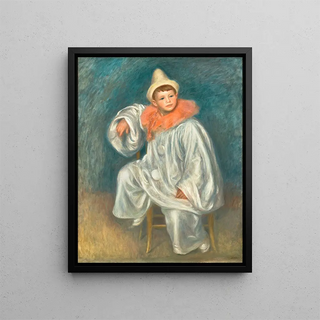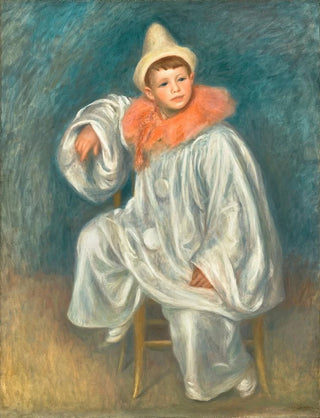Art print | Le Pierrot blanc - Pierre-Auguste Renoir


View from behind

Frame (optional)
In the vast panorama of art history, some works transcend the simple status of aesthetic objects to become symbols of an entire era. "The White Pierrot" by Pierre-Auguste Renoir is undoubtedly one of these iconic creations. Painted at the end of the 19th century, this canvas evokes not only the fleeting beauty of life but also the melancholy of an emblematic character from puppet theater. With its vibrant palette and delicate forms, Renoir invites us to immerse ourselves in a universe where light dances across the canvas, revealing the depth of human emotions.
Style and uniqueness of the work
The uniqueness of "The White Pierrot" lies in how Renoir captures the very essence of his subject. The Pierrot character, traditionally associated with sadness and melancholy, is here depicted with surprising grace and lightness. The composition of the work is marked by soft colors and fluid brushstrokes, characteristic of the Impressionist style. Renoir skillfully plays with light, creating reflections and shadows that bring the scene to life. The Pierrot, with his pale face and white costume, seems to float in a world where reality and dream intertwine. This work does not merely depict a character; it tells a story, that of an artist lost in his thoughts, between the joy of performance and the sadness of absence.
The artist and his influence
Pierre-Auguste Renoir, a major figure of Impressionism, knew how to leave his mark on his era through his innovative approach to painting. Born in 1841, he began his career painting scenes of everyday life but quickly evolved toward more complex compositions, incorporating themes of beauty and sensuality. Renoir was influenced by his contemporaries, but he also forged his own style, making light and color the central elements of his work. His impact on the art world is undeniable: he paved the way for many artists who sought to capture the fleeting nature of moments and the beauty of human emotions. "The White Pierrot" is part of this legacy.

Matte finish

View from behind

Frame (optional)
In the vast panorama of art history, some works transcend the simple status of aesthetic objects to become symbols of an entire era. "The White Pierrot" by Pierre-Auguste Renoir is undoubtedly one of these iconic creations. Painted at the end of the 19th century, this canvas evokes not only the fleeting beauty of life but also the melancholy of an emblematic character from puppet theater. With its vibrant palette and delicate forms, Renoir invites us to immerse ourselves in a universe where light dances across the canvas, revealing the depth of human emotions.
Style and uniqueness of the work
The uniqueness of "The White Pierrot" lies in how Renoir captures the very essence of his subject. The Pierrot character, traditionally associated with sadness and melancholy, is here depicted with surprising grace and lightness. The composition of the work is marked by soft colors and fluid brushstrokes, characteristic of the Impressionist style. Renoir skillfully plays with light, creating reflections and shadows that bring the scene to life. The Pierrot, with his pale face and white costume, seems to float in a world where reality and dream intertwine. This work does not merely depict a character; it tells a story, that of an artist lost in his thoughts, between the joy of performance and the sadness of absence.
The artist and his influence
Pierre-Auguste Renoir, a major figure of Impressionism, knew how to leave his mark on his era through his innovative approach to painting. Born in 1841, he began his career painting scenes of everyday life but quickly evolved toward more complex compositions, incorporating themes of beauty and sensuality. Renoir was influenced by his contemporaries, but he also forged his own style, making light and color the central elements of his work. His impact on the art world is undeniable: he paved the way for many artists who sought to capture the fleeting nature of moments and the beauty of human emotions. "The White Pierrot" is part of this legacy.






